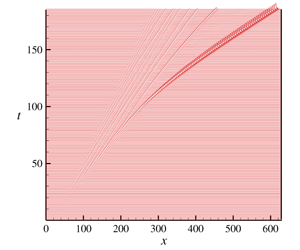Published online by Cambridge University Press: 26 May 2020

A gravity-driven water film falling down an ice sheet is considered within the framework of a long-wave approximation. The integral-boundary-layer method, modified with the account of the phase transition, is adopted to describe the evolution of both the free surface of a water film and the interface between the ice and water. A set of governing equations consisting of five coupled nonlinear partial differential equations is established. The linear instability analysis of the uniform base flow is performed, and the result is in good agreement with the Orr–Sommerfeld analysis of the linearized Navier–Stokes equations. The phase transition at the interface between the ice and water plays a role in stabilizing the system linearly with long-wavelength perturbations. The nonlinear solutions of the steady travelling waves are constructed numerically. The phase transition tends to suppress the dispersion of the interfacial wave. Comparisons to direct numerical simulation of the Navier–Stokes equations, which are performed with an extended marker and cell method, show a remarkable agreement. The integral-boundary-layer method captures the water film thickness and the topography of the ice sheet satisfactorily. The phase transition is observed to enhance the backflow phenomenon in the capillary region of the solitary-like interfacial wave.